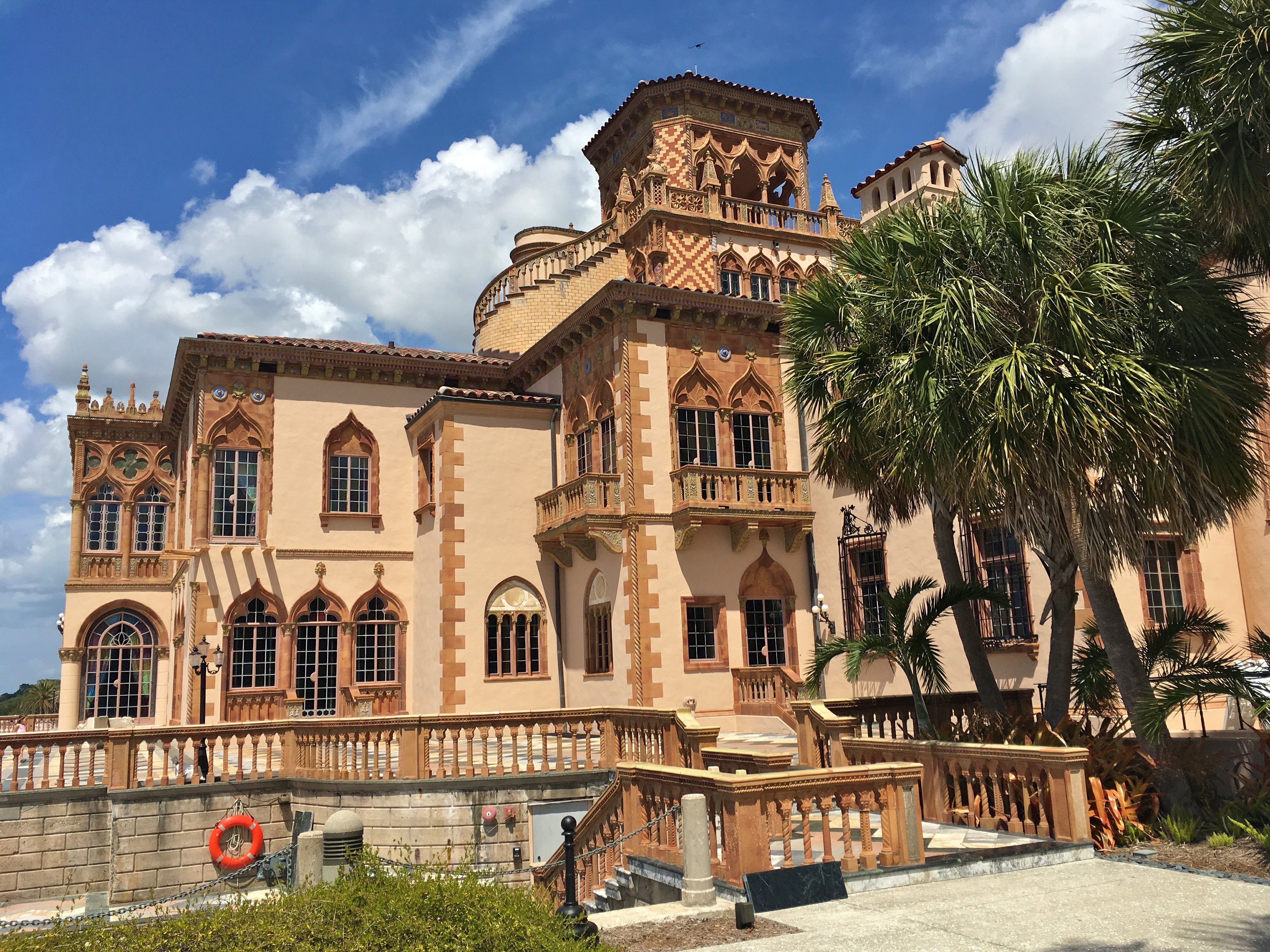|
Ca' D'Zan
Ca' d'Zan () is a Mediterranean revival mansion in Sarasota, Florida, adjacent to Sarasota Bay. Ca' d'Zan was built in the mid-1920s as the winter residence of the American circus mogul, entrepreneur, and art collector John Ringling and his wife Mable Burton Ringling. The name means "House of John" in the Venetian language, in Italian it would be "Casa di Giovanni". Since its completion in 1926, Ca' d'Zan has been admired as an architectural gem. It is a large Mediterranean revival mansion that features an eclectic array of architectural styles including Venetian Gothic, Italian Renaissance, Moorish, and Spanish-inspired elements drawn from different historic periods. The Ringlings had visited Venice, and the house's Venetian Gothic influence is prominently seen in a variety of architectural elements in the decorative program, such as windows with Gothic arches and terra cotta ornament replicating Gothic tracery. Description and history The Ringlings first came to Sarasota i ... [...More Info...] [...Related Items...] OR: [Wikipedia] [Google] [Baidu] |
Sarasota, Florida
Sarasota () is a city in Sarasota County on the Gulf Coast of the U.S. state of Florida. The area is renowned for its cultural and environmental amenities, beaches, resorts, and the Sarasota School of Architecture. The city is located in the southern end of the Greater Tampa Bay Area and north of Fort Myers and Punta Gorda. Its official limits include Sarasota Bay and several barrier islands between the bay and the Gulf of Mexico. Sarasota is a principal city of the Sarasota metropolitan area, and is the seat of Sarasota County. According to the 2020 U.S. census, Sarasota had a population of 54,842. The Sarasota city limits contain several keys, including Lido Key, St. Armands Key, Otter Key, Casey Key, Coon Key, Bird Key, and portions of Siesta Key. Longboat Key is the largest key separating the bay from the gulf, but it was evenly divided by the new county line of 1921. The portion of the key that parallels the Sarasota city boundary that extends to that new county li ... [...More Info...] [...Related Items...] OR: [Wikipedia] [Google] [Baidu] |
Willy Pogany
William Andrew Pogany (born Vilmos András Pogány; August 24, 1882 – July 30, 1955) was a prolific Hungarian illustrator of children's and other books. His contemporaries include C. Coles Phillips, Joseph Clement Coll, Edmund Dulac, Harvey Dunn, Walter Hunt Everett, Harry Rountree, Sarah Stilwell Weber, and N.C. Wyeth. He is best known for his pen and ink drawings of myths and fables. A large portion of Pogany's work is described as Art Nouveau. Pogany's artistic style is heavily fairy-tale orientated and often feature motifs of mythical animals such as nymphs and pixies. He paid great attention to botanical details. He used dreamy and warm pastel scenes with watercolors, oil paintings, and especially pen and ink. Background Pogany was born in Szeged, Austria-Hungary. He studied at Budapest Technical University and in Munich and Paris. He spent his early childhood with his brothers and sisters in a large farmhouse full of chickens, ducks, geese, dogs, pigs, and horses. W ... [...More Info...] [...Related Items...] OR: [Wikipedia] [Google] [Baidu] |
Italianate Architecture In Florida
The Italianate style was a distinct 19th-century phase in the history of Classical architecture. Like Palladianism and Neoclassical architecture, Neoclassicism, the Italianate style drew its inspiration from the models and architectural vocabulary of 16th-century Italian Renaissance architecture, synthesising these with picturesque aesthetics. The style of architecture that was thus created, though also characterised as "Neo-Renaissance", was essentially of its own time. "The backward look transforms its object," Siegfried Giedion wrote of historicist architectural styles; "every spectator at every period—at every moment, indeed—inevitably transforms the past according to his own nature." The Italianate style was first developed in Britain in about 1802 by John Nash (architect), John Nash, with the construction of Cronkhill in Shropshire. This small country house is generally accepted to be the first Italianate villa in England, from which is derived the Italianate architectur ... [...More Info...] [...Related Items...] OR: [Wikipedia] [Google] [Baidu] |
Houses In Sarasota, Florida
A house is a single-unit residential building. It may range in complexity from a rudimentary hut to a complex structure of wood, masonry, concrete or other material, outfitted with plumbing, electrical, and heating, ventilation, and air conditioning systems.Schoenauer, Norbert (2000). ''6,000 Years of Housing'' (rev. ed.) (New York: W.W. Norton & Company). Houses use a range of different roofing systems to keep precipitation such as rain from getting into the dwelling space. Houses may have doors or locks to secure the dwelling space and protect its inhabitants and contents from burglars or other trespassers. Most conventional modern houses in Western cultures will contain one or more bedrooms and bathrooms, a kitchen or cooking area, and a living room. A house may have a separate dining room, or the eating area may be integrated into another room. Some large houses in North America have a recreation room. In traditional agriculture-oriented societies, domestic animals such as c ... [...More Info...] [...Related Items...] OR: [Wikipedia] [Google] [Baidu] |
Houses Completed In 1926
A house is a single-unit residential building. It may range in complexity from a rudimentary hut to a complex structure of wood, masonry, concrete or other material, outfitted with plumbing, electrical, and heating, ventilation, and air conditioning systems.Schoenauer, Norbert (2000). ''6,000 Years of Housing'' (rev. ed.) (New York: W.W. Norton & Company). Houses use a range of different roofing systems to keep precipitation such as rain from getting into the dwelling space. Houses may have doors or locks to secure the dwelling space and protect its inhabitants and contents from burglars or other trespassers. Most conventional modern houses in Western cultures will contain one or more bedrooms and bathrooms, a kitchen or cooking area, and a living room. A house may have a separate dining room, or the eating area may be integrated into another room. Some large houses in North America have a recreation room. In traditional agriculture-oriented societies, domestic animals such ... [...More Info...] [...Related Items...] OR: [Wikipedia] [Google] [Baidu] |
Historic District Contributing Properties In Florida
History (derived ) is the systematic study and the documentation of the human activity. The time period of event before the invention of writing systems is considered prehistory. "History" is an umbrella term comprising past events as well as the memory, discovery, collection, organization, presentation, and interpretation of these events. Historians seek knowledge of the past using historical sources such as written documents, oral accounts, art and material artifacts, and ecological markers. History is not complete and still has debatable mysteries. History is also an academic discipline which uses narrative to describe, examine, question, and analyze past events, and investigate their patterns of cause and effect. Historians often debate which narrative best explains an event, as well as the significance of different causes and effects. Historians also debate the nature of history as an end in itself, as well as its usefulness to give perspective on the problems of the p ... [...More Info...] [...Related Items...] OR: [Wikipedia] [Google] [Baidu] |
Alfonso Cuarón
Alfonso Cuarón Orozco ( , ; born 28 November 1961) is a Mexican filmmaker. He is known for directing films in a variety of genres including the family drama ''A Little Princess'' (1995), the romantic drama ''Great Expectations'' (1998), the coming of age road film ''Y tu mamá también'' (2001), the fantasy film ''Harry Potter and the Prisoner of Azkaban'' (2004), the science fiction films ''Children of Men'' (2006) and ''Gravity'' (2013), the semi-autobiographical drama ''Roma'' (2018), and the 2009 short ''I Am Autism''. Cuarón has received 10 Academy Award nominations, winning four including Best Director for ''Gravity'' and ''Roma'', Best Film Editing for ''Gravity'', and Best Cinematography for ''Roma''. He is the first Mexico-born filmmaker to win the Best Director award, and one of only four people to have been nominated for Academy Awards in six different categories. Early life Cuarón was born in Mexico City, the son of Alfredo Cuarón, a doctor specializing in ... [...More Info...] [...Related Items...] OR: [Wikipedia] [Google] [Baidu] |
Great Expectations (1998 Film)
''Great Expectations'' is a 1998 American romantic drama film. A contemporary film adaptation of Charles Dickens’s 1861 novel of the same name, co-written and directed by Alfonso Cuarón and starring Ethan Hawke, Gwyneth Paltrow, Hank Azaria, Robert De Niro, Anne Bancroft and Chris Cooper. It is known for having moved the setting of the original novel from 1812-1827 London to 1990s New York. The film is an abridged modernization of Dickens's 1861 novel, with the hero's name having been changed from Pip to Finn, and the characters of Miss Havisham having been renamed Nora Dinsmoor and Abel Magwitch being renamed to Arthur Lustig. The film received mixed reviews. Plot Ten-year-old Finnegan "Finn" Bell, an orphan being raised by his elder sister Maggie and her boyfriend Joe, is overpowered by an escaped convict while playing on a beach on the Gulf Coast. Finn brings him food, alcohol and bolt cutters to get the iron shackles off his leg, and is taken hostage. The convict trie ... [...More Info...] [...Related Items...] OR: [Wikipedia] [Google] [Baidu] |
American Institute Of Architects
The American Institute of Architects (AIA) is a professional organization for architects in the United States. Headquartered in Washington, D.C., the AIA offers education, government advocacy, community redevelopment, and public outreach to support the architecture profession and improve its public image. The AIA also works with other members of the design and construction community to help coordinate the building industry. The AIA is currently headed by Lakisha Ann Woods, CAE, as EVP/Chief Executive Officer and Dan Hart, FAIA, as 2022 AIA President. History The American Institute of Architects was founded in New York City in 1857 by a group of 13 architects to "promote the scientific and practical perfection of its members" and "elevate the standing of the profession." This initial group included Cornell University Architecture Professor Charles Babcock, Henry W. Cleaveland, Henry Dudley, Leopold Eidlitz, Edward Gardiner, Richard Morris Hunt, Detlef Lienau, [...More Info...] [...Related Items...] OR: [Wikipedia] [Google] [Baidu] |
National Register Of Historic Places
The National Register of Historic Places (NRHP) is the United States federal government's official list of districts, sites, buildings, structures and objects deemed worthy of preservation for their historical significance or "great artistic value". A property listed in the National Register, or located within a National Register Historic District, may qualify for tax incentives derived from the total value of expenses incurred in preserving the property. The passage of the National Historic Preservation Act (NHPA) in 1966 established the National Register and the process for adding properties to it. Of the more than one and a half million properties on the National Register, 95,000 are listed individually. The remainder are contributing resources within historic districts. For most of its history, the National Register has been administered by the National Park Service (NPS), an agency within the U.S. Department of the Interior. Its goals are to help property owners an ... [...More Info...] [...Related Items...] OR: [Wikipedia] [Google] [Baidu] |
Contributing Property
In the law regulating historic districts in the United States, a contributing property or contributing resource is any building, object, or structure which adds to the historical integrity or architectural qualities that make the historic district significant. Government agencies, at the state, national, and local level in the United States, have differing definitions of what constitutes a contributing property but there are common characteristics. Local laws often regulate the changes that can be made to contributing structures within designated historic districts. The first local ordinances dealing with the alteration of buildings within historic districts was passed in Charleston, South Carolina in 1931. Properties within a historic district fall into one of two types of property: contributing and non-contributing. A contributing property, such as a 19th-century mansion, helps make a historic district historic, while a non-contributing property, such as a modern medical clinic, ... [...More Info...] [...Related Items...] OR: [Wikipedia] [Google] [Baidu] |






.jpg)
.jpg)

